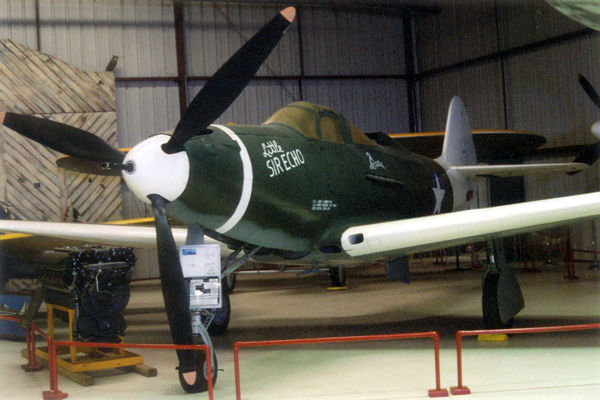
Bell P-39N Airacobra
When the U. S. Army Air Corps issued specification No. X-609 in March
1937, Robert J. Woods, chief engineer at the Bell Aircraft Corporation,
was ready. Two months later, Woods proposed the Bell Model 4 to meet this
specification for a highly manoeuvrable fighter aeroplane with good visibility,
heavy firepower, exceptional takeoff and landing qualities, and better
ground handling than existing types. The Air Corps was impressed enough
to award Bell a contract for a single prototype, designated XP-39, on
7th October 1937, and the P-39 was born.
Woods designed the P-39 around one primary component, the 37mm cannon.
Considerable trial and error was required to avoid sacrificing the important
airframe and engine requirements, such as speed and manoeuvrability, to
the cannon's weight, size, and recoil characteristics. One arrangement
had the cockpit located behind both the engine and the cannon but poor
visibility ruled out this version. The final scheme mounted the engine
amidships behind the pilot and cannon. A long drive shaft connected the
engine and propeller gearbox. The cannon was located between the pilot
and the propeller so that the gun could fire through the propeller hub.
Woods envisioned the large space under the cannon, as a place to store
the retractable nose wheel and the Airacobra became the first Air Corps
single-engine aeroplane with a tricycle landing gear.
Bell built the XP-39, U. S. Army Air Corps serial number 38-326, at its
plant in Buffalo, New York. When the new fighter made its first flight
on 6th April 1939, a turbo-supercharged Allison V-1710-17 engine powered
the aircraft to a speed of nearly 627.9 km/h (390 mph) at 6,080 m (20,000
ft). Two months after the first flight, the National Advisory Committee
on Aeronautics (NACA) at Langley, Virginia, studied the XP-39 and recommended
a list of modifications. It was primarily interested in streamlining to
reduce drag but the modifications they ordered increased the loaded weight
by 114 kg (250 lb) to 2,903 kg (6,450 lb). Even more damning, NACA advised
the Air Corps to remove the turbo-supercharger, and it apparently agreed,
believing that an engine with a geared supercharger was close at hand.
However, Allison was years away from fielding such a power plant and when
it did, newer and more advanced airframes became the logical recipients.
Without this vital component, the P-39 became unsuitable for combat above
about 6,080 m (20,000 ft).
With war clouds gathering, the Air Corps contracted with Bell for eighty
production aeroplanes designated the P-39C (twenty aeroplanes) and the
P-39D (sixty aeroplanes). To supplement the cannon, Bell armed the P-39C
with two .50 and two .30 calibre machine guns mounted in the upper nose
cowling to fire through the propeller. The company relocated the .30 calibre
gun battery to the wings and doubled their number on the P-39D. Foreign
air forces, debilitated by years of fiscal neglect, frantically bought
up the first Airacorbras. In 1940, the French and the British each signed
contracts for hundreds of export Airacobras. The order came too late for
the French and the British found nothing to like in the P-39 so many of
these aeroplanes were redirected to the Air Corps and re-designated as
P-400s. The British Government sent most its P-39s to the Soviet Union.
The Army Air Corps had absorbed 179 Airacobras destined for England and
most of these fighters went into action in the Pacific Theatre with the
8th Pursuit Group at Port Moresby, New Guinea, in April 1942. For the
next year-and-a-half, the best fighter aircraft the United States could
field were P-39's and Curtiss P-40's.
The P39 had an unusual configuration, in that the engine was behind the
pilot, a long shaft between the pilot's legs drove propeller & the
37mm cannon fired through the propeller hub. When P-39 production ended in August 1944, Bell had built 9,584 Airacobras, of which 2,095 were P39N's.